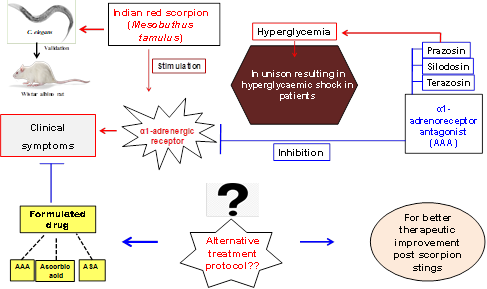Novel Therapeutic Formulation Shows Promise in Treating Indian Red Scorpion Stings

In a groundbreaking development, scientists have introduced a novel therapeutic drug formulation (TDF) that offers a potential breakthrough in the treatment of Indian red scorpion stings. Scorpion envenomation, particularly from the Indian red scorpion (Mesobuthus tamulus), poses a severe threat to individuals in many regions, and the existing treatment methods have faced limitations.
Traditionally, intravenous administration of equine anti-scorpion antivenom (ASA) has been the primary approach to counter scorpion stings. However, this method has been hampered by a low proportion of venom-specific antibodies against the most abundant low molecular mass channel toxin, often leading to adverse reactions in patients.
Moreover, the conventional use of α1-adrenoreceptor agonists (AAAs) alone or in combination with ASA has been somewhat effective but has its drawbacks. To address these challenges, a team of scientists from the Institute of Advanced Study in Science and Technology (IASST) and researchers from Tezpur University and NIELIT, Guwahati, have developed a novel TDF. This formulation combines low doses of commercial ASA, AAAs, and vitamin C to inhibit Indian red scorpion venom-induced toxicity and its associated symptoms.
The effectiveness of this groundbreaking drug was initially assessed using Caenorhabditis elegans, a free-living nematode model. This offered an alternative to in vivo animal models and yielded promising results. The research has been published in the journal Toxins, and an Indian patent has been filed for this innovative drug formulation.
The study’s team, including Prof. Ashis Mukherjee and Dr. M. R. Khan from IASST, Dr. Bhabana Das and Upasana Pujari from Tezpur University, and Dr. S. Mahanta from NIELIT, Guwahati, demonstrated the potency of this TDF. It efficiently neutralized Indian red scorpion venom, resulting in a significant reduction in blood glucose levels, organ tissue damage, necrosis, and pulmonary edema in Wistar rats, outperforming commercial ASA, AAA, and vitamin C.
This groundbreaking treatment holds the promise of more effective management and potentially life-saving interventions for scorpion sting patients worldwide. The innovative TDF represents a significant step forward in addressing the challenges of scorpion envenomation and its treatment.
For more information, please visit the publication at this link or contact Prof. Ashis Mukherjee at akm@tezu.ernet.in or Dr. M. R. Khan at mojibur.khan@iasst.gov.in for further details.




